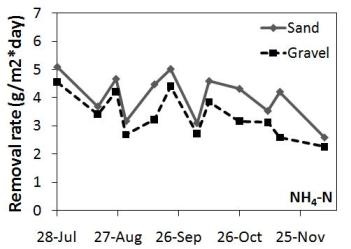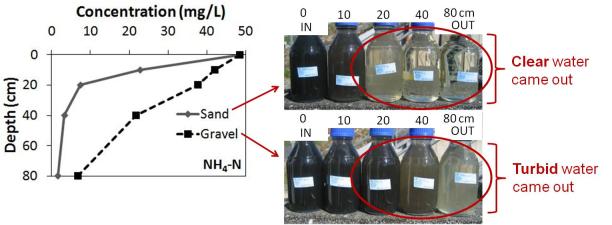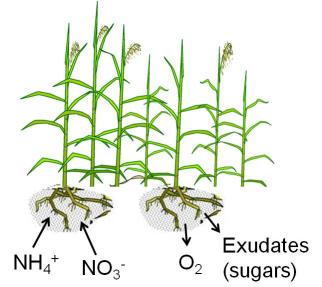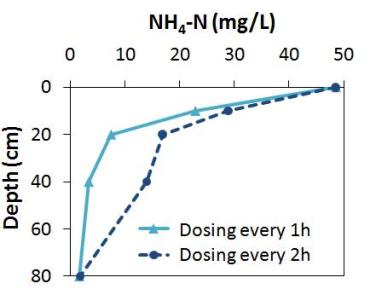Findings and conclusions
Which designs cleaned the wastewater most efficiently?

1. Sand or gravel?
We found that VF CWs with sand generally cleaned the wastewater more efficiently than those with gravel. The sand VF CWs removed a larger amount of pollutants (for organic material, ammonium-nitrogen and E. coli), and the water came out visibly clearer than in the gravel VF CWs. Oxygen levels were always higher in sand VF CWs, which is probably an important reason to why they performed better. Most of the microorganisms that remove pollutants work better with a good oxygen supply. On the other hand, total nitrogen (the sum of all nitrogen forms) was removed more efficiently in the gravel VF CWs. The reason is probably that the denitrifying bacteria, which take care of the last step of nitrogen removal, work better without oxygen.
Even though there were advantages and disadvantages with both bed materials, sand gave the best cleaning result in most aspects. Because the grain size is smaller, the total grain surface area is larger - this means a larger area where microorganisms can grow and where oxygen can be brought into the water. Also, the physical filtration effect is better with a smaller grain size.


2. Plants?
VF CWs with plants on average removed more ammonium-nitrogen (96%) than those without plants (94%). This can be an effect of the roots taking up ammonium-nitrogen, and also releasing oxygen and sugar which makes the nitrifying (ammonium-removing) bacteria more active. The plants did not affect the removal of organic material and bacteria. The benefit of plants might not be large, but since they can help it can be good to have them.

3. Dosing how often?
When wastewater was applied more often with smaller doses (every hour with a smaller dose, instead of every 2 hours with a larger dose), more pollutants were removed in the upper part of the VF CW – this means more efficient removal. The reason is probably that a smaller dose flows more slowly through the bed, which gives more time for the microorganisms to remove pollutants. However, care needs to be taken so that doses are not applied too often – the wetland needs to rest after each dose to refill the pores with oxygen for the working microorganisms.
We conclude that...
...sand is in most aspects a better bed material than gravel due to the smaller grain size, which gives more surface area where microorganisms can grow, better oxygenation and better filtering capacity.
...plants can help to remove nitrogen, e.g. through uptake by the roots, but the effect is not large.
...smaller doses of wastewater that are applied more often gives a more efficient pollutant removal, since the microorganisms have more time to remove pollutants when the water flows more slowly.
Responsible for this page:
Director of undergraduate studies Biology
Last updated:
05/22/11
